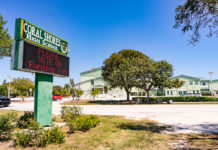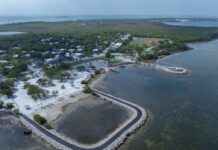A request to change two parcels of property on the Old Highway from residential conservation to mixed use was turned down by the Islamorada Village Council during a meeting on Dec. 2. The four-hour meeting saw sides going back and forth over the proposed change, which property owner Michael Murphy was seeking in order to construct a two-story mixed-use structure that would have brought affordable housing to the village.
The property is located between U.S. 1 and the Old Highway at the intersection of Coral Way on Plantation Key. To the northeast, properties are mostly undeveloped residential conservation with a maximum density of one dwelling unit per 4 acres. To the east and southeast, property is residential low, meaning there’s a maximum density of one unit per 2 acres. To the southwest across Coral Way are properties zoned highway commercial with mixed, non residential uses.
One of the main contention points surrounded the quality of trees on the lots, which together total 24,000 square feet. According to a staff report, a habitat evaluation by the applicant’s biologist, Travis Ferguson, in July 2021 initially classified the two lots as “low quality” hammock. A classification of low quality would allow the clearing limit of 50%, or 12,000 square feet. Lots owned by Murphy contain gumbo limbo, poisonwood, Jamaican dogwood and mahogany, among others.
Analysis by the village, however, classified the parcels as “high quality,” which would only allow 10% of the trees to be cleared. According to a village staff report, a village habitat evaluation index handbook showed that parcels owned by Murphy are part of a 25-acre area of hammock. Based on patch size and the village’s scoring based on the index handbook, the parcels would be “accurately classified as high quality hammock.” A review by Phillip Frank, who created the village’s habitat evaluation index development regulations, confirmed the village’s analysis.
A change in the future land use map would increase development possibilities of the vacant property, according to the village’s staff report, allowing the owner to develop two market-rate dwelling units, deed-restricted affordable units, non-residential area or transient units. Murphy submitted a conceptual site plan for one of the lots, which indicated a 944-square-foot office with two deed-restricted residential dwelling units on the second floor.
At the end of discussion, village council members weren’t on board with the change from residential conservation to mixed use. A vote to deny the change was 4-0. Mayor Buddy Pinder abstained.
Councilman David Webb said there’s a need for affordable housing in the village. He said there are other opportunities to build affordable housing where. According to a staff analysis, there are approximately 39 acres of 156 vacant lots designated mixed use within the village’s future land use map.
“There are a lot of other questions that need to be asked. One is what is the need for affordable housing, what would the community pay and where would the money come from?” Webb said. “This is about whether we are going to promote destruction of the remaining environment we have. My middle ground cannot be cutting down a tree.”
Councilman Mark Gregg shared similar sentiments.
“We desperately need affordable housing and we want to protect the habitat,” he said. “We can’t cannibalize one for the other. It shouldn’t come at the expense of the environment. That’s why we’re all here and why people come to visit us.”
Vice Mayor Pete Bacheler said there’s a whopping difference between cutting 10% of trees on the property or 50%.
“One of the evaluations came from a biologist with many years of experience, and he says it’s a high quality hammock, clear 10%. It doesn’t matter the size of property, it’s in a 24-acre parcel, which you can only clear 10%.”
Murphy took to the podium following comments from council members to explain that he received pre-approval from the village’s previous administration under Seth Lawless, then manager, and Ty Harris, then planning director, before he bought the property. He also said that there wasn’t a biology report when the project was going through the Local Planning Agency, which recommended the project be denied.
“I asked what can I do with this piece of property if I buy it,” Murphy said. (They said) ‘Well, we don’t want you to build a house, but we’ll allow commercial building with affordable housing on top of it.’”
Murphy added that he hasn’t seen the village or anybody in the village that is solving the employee housing problem.























